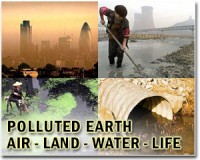| . |  |
. |
Livermore CA (SPX) Feb 16, 2010 Through Laboratory soil cleanup methods, residents of Bikini, Enjebi and Rongelap Islands - where nuclear tests were conducted on the atolls and in the ocean surrounding them in the 1950s - could have lower radioactive levels than the average background dose for residents in the United States and Europe. The National Nuclear Security Administration's Lawrence Livermore National Laboratory scientists Bill Robison and Terry Hamilton calculated the radiation doses for people resettling Bikini, Enjebi, Rongelap and Utrok Islands. The two found that when it rains, a portion of the soluble cesium-137 (137Cs) - an isotope of cesium - is transported to the groundwater that lies about three meters below the soil surface. The groundwater eventually gets mixed with the ocean waters so the 137Cs is lost from the soil and is not available for uptake by growing vegetation on the island. The rate of this loss process is much faster than the loss by radiological decay. In addition, treatment of food crops with potassium reduces the 137Cs concentration in edible fruits to about 5 percent of pretreatment concentrations. Potassium treatment and removal of the top 15 centimeters of soil around houses and community buildings prior to construction of new buildings to reduce external exposure where people spend most of their time - referred to as the combined option - could be used as a remediation strategy before resettlement, Robison said. "If this approach is taken, the natural background dose plus the nuclear-test-related dose at Bikini, Enjebi and Rongelap would be less than the usual background dose in the United States and Europe," Hamilton said. The United States conducted 24 nuclear tests at Bikini Atoll with a total yield of 76.8 megatons (MT). The Castle series of tests produced about 60 percent of this total yield and included the 15-megaton Bravo test that was the primary source of radioactive contamination of Bikini Island and Rongelap and Utrok Atolls. Pretest estimated yield for the Bravo test was about five megatons. The much larger yield resulted in vaporization of more coral reef and island than expected and the debris-cloud reached a much higher altitude than anticipated. High-altitude winds were to the east at the time of detonation and carried the radioactive debris toward Rongelap Atoll. Utrok Atoll also received fallout from the Bravo test but at much lower air and ground-level concentrations than at Rongelap Atoll. Other atolls received Bravo fallout at levels below that of Utr_k. Today, scientists in Lawrence Livermore's Marshall Islands Dose Assessment and Radioecology Program work to minimize exposure through ingestion and other pathways for the Marshallese now living on or wishing to return to their islands. The program continues research begun nearly 30 years ago to characterize radiological conditions on affected islands and develop strategies to minimize radiological exposure to a people who want to resettle. The program also supports Marshallese efforts to implement radiation protection programs for residents wishing to track their exposure to radionuclides from fallout contamination that still lingers on the islands. Previous assessments showed that 137Cs accounts for about 98 percent of the total dose for returning resident at the various atolls. About 85 percent to 90 percent of the dose (depending on the atoll) is from consumption of locally grown foods such as coconut meat and fluid, copra meat and milk, Pandanus fruit and breadfruit. About 10 percent of the dose is due to external gamma radiation from 137Cs in the soil. Isotopes of strontium, plutonium and americium account for less than 5 percent of the estimated dose.
Share This Article With Planet Earth
Related Links Lawrence Livermore National Laboratory Our Polluted World and Cleaning It Up
 Nuclear test islands might be resettled
Nuclear test islands might be resettledLivermore, Calif. (UPI) Feb 11, 2009 U.S. scientists say soil cleanup methods might be effective in allowing residents to resettle on some islands where 1950 nuclear tests were held. Researchers Bill Robison and Terry Hamilton of the Lawrence Livermore National Laboratory calculated the radiation doses for people possibly returning to Bikini, Enjebi and Rongelap Islands and found some could have lower radioactive levels th ... read more |
|
| The content herein, unless otherwise known to be public domain, are Copyright 1995-2010 - SpaceDaily. AFP and UPI Wire Stories are copyright Agence France-Presse and United Press International. ESA Portal Reports are copyright European Space Agency. All NASA sourced material is public domain. Additional copyrights may apply in whole or part to other bona fide parties. Advertising does not imply endorsement,agreement or approval of any opinions, statements or information provided by SpaceDaily on any Web page published or hosted by SpaceDaily. Privacy Statement |